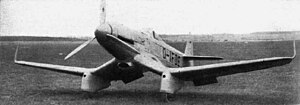Blohm & Voss Ha 137
| Blohm & Voss Ha 137 | |
|---|---|
 Blohm & Voss Ha 137 |
|
| Type: | Dive fighter |
| Design country: | |
| Manufacturer: | |
| First flight: |
January 18, 1935 |
| Number of pieces: |
at least 6 |
The Blohm & Voss Ha 137 was a German light dive fighter aircraft manufactured by the aircraft manufacturer Hamburger Flugzeugbau GmbH , a subsidiary of the Blohm & Voss shipyard.
history
The machine emerged from the design competition in the summer of 1934, in which, at the suggestion of Ernst Udet , the development group of the Technical Office in the Reich Ministry of Aviation requested a light, single-seat dive combat aircraft. In addition to the Ha 137, Fieseler with the Fi 98 and Henschel with the Hs 123 participated in the tender , of which Henschel's design won in the end. The tender for a heavy, two-seater dive fighter aircraft, for which Arado developed the Ar 81 , Heinkel the He 118 and Junkers the Ju 87 , which ran at the same time but completely independently of it , has nothing to do with this. However, the two processes are often not clearly separated in the literature.
The development of the Ha 137 began in June 1934. On January 1, 1935, before the first flight , the RLM decided to manufacture 343 units. The maiden flight of the Ha 137 V1 D-ITEK with test pilot (then called "Einflieger") Helmut Wasa Rodig took place on January 18, 1935 in Fühlsbüttel , followed by the V2 D-IXAX on May 13, 1935. The first machine ( License plate D-ITEK, serial number 107) was equipped with a BMW 132 radial engine and the first tests went smoothly. The only problem was the lack of landing flaps, which led to high landing speeds of over 120 km / h. After the manufacturer's first test flights, the RLM ordered 16 pre-series copies. The third prototype V3 (registration D-IZIQ, serial number 103) flew on April 13, 1935 and was equipped with a Rolls-Royce-Kestrel in-line engine. Less than a month later, on May 13, 1935, the V2 (registration: D-IXAX, serial number 108) also flew, which like the V1 had a BMW 132 engine . The fourth prototype finally flew on November 11, 1935 and was equipped with a Jumo 210 in-line engine.
The Luftwaffe tested the model regardless of the manufacturer at the Luftwaffe test center in Rechlin. Four prototypes and the first pre-series machine were used. Significant deficiencies were found here. Among other things, a lack of stability around the transverse axis, unbalanced rudder forces and tilting in steep curves were found. The number of machines built in total is stated differently in the literature. For the most part, six prototypes are considered to be secure, based on the number of pre-series machines Ha 137 A-0 (16 planned, D-IBGI and D-IONU are known as identifiers) and Ha 137 B-0 (D-IFOE and D-IUXU ) there is disagreement.
construction
The Ha 137 was very similar to the Ki-5 single-seater fighter previously designed by designer Richard Vogt in Japan at Kawasaki in 1933 . Like this one, it was a cantilever low- wing aircraft with gull wings in all-metal construction, the specialty of which was the tubular spar used by Richard Vogt in all of his subsequent designs, which also served as a fuel tank. The undercarriage had trouser leg cladding, in which the two rigidly installed MG 17 and MG FF were also housed at the top. The pilot sat in an open cockpit.
use
Due to the unsatisfactory flight characteristics and the loss of the RLM tender, the built Ha 137 were mainly used as objects of deception at bogus airports. Today there is no copy left.
Technical specifications
| Parameter | Data (Ha 137 B-0) |
|---|---|
| crew | 1 |
| span | 11.15 m |
| length | 9.47 m |
| height | 4.0 m |
| Wing area | 23.5 m² |
| Wing extension | 5.3 |
| Wing loading | 103 kg / m² |
| Power load | 4.5 kg / hp |
| Area performance | 23 hp / m² |
| payload | 600 kg |
| Preparation mass | 1815 kg |
| Max. Takeoff mass | 2415 kg |
| Marching speed | 290 km / h at an altitude of 2000 m |
| Top speed | 330 km / h at an altitude of 2000 m |
| Landing speed | 105 km / h |
| Rise time | 9 min at 4000 m altitude |
| Service ceiling | 7000 m |
| Range | 580 km |
| Engines | 1 × Junkers Jumo 210 C, 640 PS (471 kW) takeoff power |
See also
literature
- Hermann Pohlmann: Chronicle of an aircraft factory . Motorbuchverlag, ISBN 3-87943-624-X .
- Hans Redemann: Ha 137 - The Stuka from Blohm & Voss . In: Flug Revue March 1971, p. 42 ff.
Web links
Individual evidence
- ↑ "Flieger" type book series, factory chronicles, Volume 8, Hamburger Flugzeugbau, Blohm & Voss , p. 28
- ↑ a b c Arthur Löffler: The first attempt . In: FLIGHT REVIEW . No. 11, 2013, pp. 92-95.
- ↑ Bruno Lange: Type Handbook of German Aviation Technology - Die deutsche Luftfahrt , Volume 9, P. 106 f.
- ↑ Werner von Langsdorff : Handbook of aviation . Born in 1939. 2nd, unchanged edition. J. F. Lehmann, Munich 1937, p. 208 .
